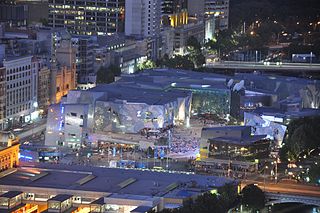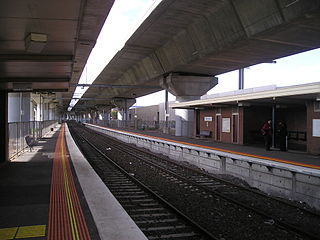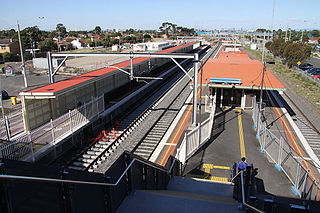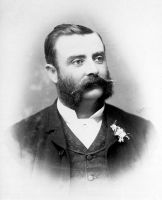
Federation Square is a venue for arts, culture and public events on the edge of the Melbourne central business district. It covers an area of 3.2 ha at the intersection of Flinders and Swanston Streets built above busy railway lines and across the road from Flinders Street station. It incorporates major cultural institutions such as the Ian Potter Centre and ACMI and Koorie Heritage Trust as well as cafes and bars in a series of buildings centred around a large paved square, and a glass walled atrium. The corner is occupied by a glass walled pavilion that provides access to the underground Melbourne Visitor Centre.

Richmond railway station is located on the Alamein, Belgrave, Cranbourne, Frankston, Glen Waverley, Lilydale, Pakenham and Sandringham lines in Victoria, Australia. It serves the south-eastern Melbourne suburb of Richmond opening on 12 December 1859 as Swan Street, being renamed Richmond on 1 January 1867.

East Camberwell railway station is located on the Lilydale and Belgrave lines in Victoria, Australia, serving the eastern Melbourne suburb of Camberwell. It opened on 14 May 1900, as the interchange station for the Deepdene Dasher service, which ran north along the Outer Circle line, that had opened in 1891.

Hawksburn railway station is located on the Pakenham, Cranbourne and Frankston lines, in Victoria, Australia. It opened on 7 May 1879, and serves the south-eastern Melbourne suburb of South Yarra.

Merinda Park railway station is a railway station on the South Gippsland line in Melbourne, Victoria, Australia. The station is located on the suburb boundary of Cranbourne North and Lyndhurst, opening on 24 March 1995 as part of the electrification of the line to Cranbourne.

North Melbourne railway station is located on the northern edge of the central business district of Melbourne, Australia. The station is a major interchange point with the Craigieburn, Flemington Racecourse, Sunbury, Upfield, Werribee and Williamstown lines all servicing the station. It opened on 6 October 1859, and is listed on the Victorian Heritage Register.

Macaulay railway station is located on the Upfield line in Victoria, Australia. It serves the northern Melbourne suburbs of Kensington and North Melbourne, and opened on 1 December 1887 as Macaulay Road. It was renamed Macaulay on 1 May 1909.

Moreland railway station is located on the Upfield line, in Victoria, Australia. It serves the northern Melbourne suburb of Coburg, and opened on 9 September 1884.

Newport railway station is the junction station for the Werribee and Williamstown lines in Victoria, Australia. It serves the western Melbourne suburb of Newport.

Laverton railway station is located on Werribee line, in the western Melbourne suburb of Laverton. It opened on 1 July 1886.

William Pitt was an Australian architect and politician. Pitt is best known as one of the outstanding architects of the "boom" era of the 1880s in Melbourne, designing some of the city's most elaborate High Victorian commercial buildings. He worked in a range of styles including Gothic Revival, Italianate, French Second Empire, and his own inventive eclectic compositions. He had a notable second career after the crash of the 1890s, becoming a specialist in theatres and industrial buildings.

East Melbourne is an inner suburb of Melbourne, Australia, 2 km east of Melbourne's Central Business District. Its local government area is the City of Melbourne.

Spring Street is a major street in the central business district of Melbourne, Australia. It runs roughly north-south and is the easternmost street in the original 1837 Hoddle Grid.

Russell Street is a main street and thoroughfare in the central business district of Melbourne, Australia. It runs roughly north-south and was laid out as a core feature of the Hoddle Grid in 1837.

The Melbourne and Hobson's Bay Railway Company was a railway company in Victoria, Australia. The company was founded on 20 January 1853 to build the line from Melbourne to the port of Sandridge. It was constructed to the 'Irish' broad gauge of 1,600 mm, as the result of an agreement between the then-colonies in Australia to adopt that gauge. This was the first common-carrier railway to operate in Australia. It opened on 12 September 1854, more than a year before the Sydney–Parramatta Railway in NSW, which opened on 26 September 1855.

Jolimont Yard was an array of railway lines and carriage sidings on the edge of the central business district of Melbourne, Australia. Located between Flinders Street station, Richmond Junction, the Yarra River and Flinders Street they were often criticised for cutting off the city from the river, being the site of many redevelopment proposals. The Princes Gate Towers were built over part of the yard in the 1960s, which themselves were replaced by Federation Square in the 1990s. The rail sidings themselves were progressively removed from the 1980s to the 1990s with only running lines today, but the area continues to be referred to as the 'Jolimont railyards' by Melburnians.
The Noojee railway line is a closed railway line in Victoria, Australia. Branching off from the Gippsland line at Warragul station, it was built to service the timber industry in the upper Latrobe River area, transporting timber as well as providing a general goods and passenger service to townships in the area. The final section of the line between Neerim South and Noojee traversed increasingly hilly terrain and featured a number of large timber trestle bridges. Extensively and repeatedly damaged by bushfires over the years, the line was closed in the 1950s and dismantled. The last remaining large trestle bridge on the line has been preserved and has become a popular local tourist attraction.

The architecture of Melbourne, the second most populous city in Australia, is characterised by an extensive juxtaposition of old and new architecture. The city is noted for preserving a significant amount of Victorian architecture and has some of the largest in the country. Additionally, it features a vast array of modern architecture, with around 60 skyscrapers over 100 m in the city centre which have deliberately been set back from thoroughfares and streets to preserve historic architecture—leading to the title of "Australia's most European city".
Robert Joseph Haddon (1866–1929) was an England-born architect who practised in Victoria in the 1900s-1910s. He was a major figure in the profession in Victoria, championing the Arts & Crafts in his writing and teaching. He designed some of the most original buildings of the period, featuring restraint, balanced asymmetry and Art Nouveau details.
























